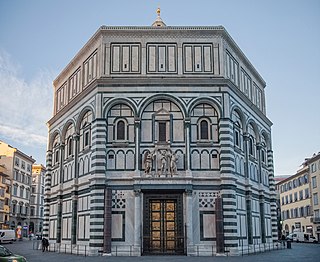
The Florence Baptistery, also known as the Baptistery of Saint John, is a religious building in Florence, Italy. Dedicated to the patron saint of the city, John the Baptist, it has been a focus of religious, civic, and artistic life since its completion. The octagonal baptistery stands in both the Piazza del Duomo and the Piazza San Giovanni, between Florence Cathedral and the Archbishop's Palace.

San Miniato al Monte is a basilica in Florence, central Italy, standing atop one of the highest points in the city. It has been described as one of the finest Romanesque structures in Tuscany and one of the most scenic churches in Italy. There is an adjoining Olivetan monastery, seen to the right of the basilica when ascending the stairs.

The Cimitero Monumentale is one of the two largest cemeteries in Milan, Italy, the other one being the Cimitero Maggiore. It is noted for the abundance of artistic tombs and monuments.

The Campo Verano is a cemetery in Rome, Italy, founded in the early 19th century. The monumental cemetery covers a surface area of 83 hectares which is currently divided into several sections: the main Catholic cemetery, the Jewish cemetery established in 1895, a Protestant section with its own entrance and a military section with monument to the victims of World War I.

San Miniato is a town and comune in the province of Pisa, in the region of Tuscany, Italy.

Ferdinando Fuga was an Italian architect who was born in Florence, and is known for his work in Rome and Naples. Much of his early work was in Rome, notably, the Palazzo della Consulta (1732–7) at the Quirinal, the Palazzo Corsini (1736–54), the façade of the Santa Maria Maggiore (1741–3), and the Church of Sant'Apollinare (1742–8). He later moved to Naples and notably designed the Albergo de'Poveri (1751–81), the façade of the Church of the Gerolamini, and that of the Palazzo Giordano.

The Monumental Cemetery of Bonaria is located in Cagliari, Sardinia. In use between 1829 and 1968, this monumental cemetery originally occupied an area at the base of the hill of Bonaria, and over time expanded upwards. The main entrance is located in Piazza Cimitero, with a second entrance in Ravenna, at the Basilica of Bonaria. Several famous people were buried in Bonaria, including the canonical archaeologist Giovanni Spano, the tenor Piero Schiavazzi and General Carlo Sanna.

Marietta Piccolomini was an Italian soprano. She was most famous for the role of Violetta in La Traviata by Giuseppe Verdi, which she performed in England, France, and the United States, as well as her native Italy. After her marriage in 1863, she retired from performing, making only rare charity or courtesy appearances thereafter.

Tito Sarrocchi was an Italian sculptor.
The Cemetery of the 366 Fossae or Cimitero di Santa Maria del Popolo or Cimitero dei Tredici was built in 1762 a short distance from the then-dilapidated Villa Poggio Reale, and is located on a terrace of a hill overlooking the Poggioreale neighborhood of Naples, Italy. It is near the monumental Cemetery of Poggioreale, which was built on top of the ruined villa. The architect was the Florentine Ferdinando Fuga.

Giovanni Berta was an Italian fascist militant of the Florentine Squadrismo, later killed by communist militants during the Pignone clashes in Florence.
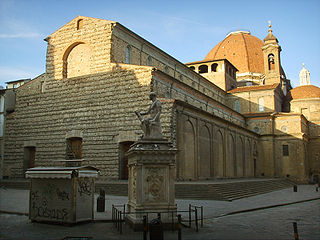
Piazza San Lorenzo is a city square in Florence, Italy, with the Basilica of San Lorenzo, Florence situated at the centre.

Pasquale Romanelli was an Italian sculptor, and apprentice of Lorenzo Bartolini.
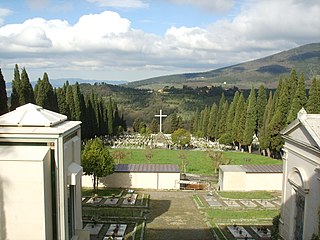
The Cimitero di Trespiano is a cemetery along the Via Bolognese near Florence, Italy, named after the hamlet of Trespiano in the hills north of Fiesole.
The Jewish monumental cemetery in Florence is a monumental cemetery on the current Ariosto avenue, just outside the ancient Renaissance walls, as it was not allowed to bury Jews in the city. It is open once a month, only on last Sundays, with two guided tours in the morning.
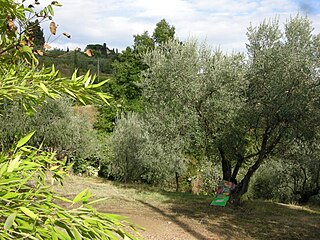
Cimitero delle Ballodole was in Florence in the homonymous resort, about a mile south of the current Cimitero di Trespiano.

The Monumental Cemetery of Brescia is one of the first and most ancient monumental cemetery in Italy. It was the first construction project by the Neoclassical architect Rodolfo Vantini, who started its erection in 1813 and dedicated his whole life to its creation.
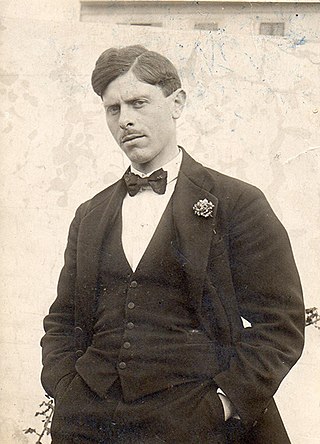
Giacomo Delcroix was an Italian landscape and still life painter.

The Monumental Cemetery of Mortara is located in the north-eastern outskirts of the city of Mortara, an Italian comune in the province of Pavia, in the region of Lombardy in northern Italy. The Monumental Cemetery of Mortara is one of the biggest and most important cemeteries in the Lomellina area.
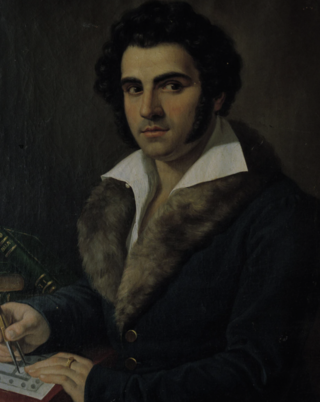
Niccolò "Nicola" Matas was an Italian architect and professor. He is best known for being the architect of the 19th century Gothic Revival façade of the Basilica of Santa Croce in Florence, Italy. Matas was a professor at the Academy of Fine Arts, Florence. He is one of the important architects in the history of the city of Florence.



















